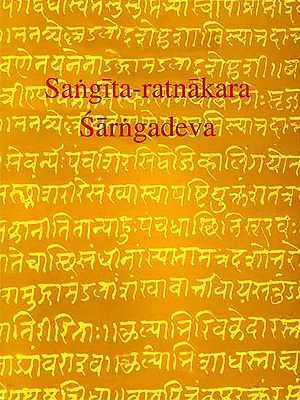 Sangita-Ratnakara authored by Sarangadeva vividly explains both Hindustani music and Carnatic music. It is also known as Saptadhyayi. This book is divided into seven different chapters. The first six chapters are named as Svaragatadhyaya, Ragavivekadhyaya, Prakirnakadhyaya, Prabandhadhyaya, Taladhyaya and Vadyadhyaya and consist of various facets of music and musical instruments. The last section of Sangita-Ratnakara is called Nartanadhyaya as it deals with dance. This text also furnishes some curious notices of theatrical representation and gesture.
Sangita-Ratnakara authored by Sarangadeva vividly explains both Hindustani music and Carnatic music. It is also known as Saptadhyayi. This book is divided into seven different chapters. The first six chapters are named as Svaragatadhyaya, Ragavivekadhyaya, Prakirnakadhyaya, Prabandhadhyaya, Taladhyaya and Vadyadhyaya and consist of various facets of music and musical instruments. The last section of Sangita-Ratnakara is called Nartanadhyaya as it deals with dance. This text also furnishes some curious notices of theatrical representation and gesture.
The important commentaries on the text include the Sangitasudhakara of Simhabhupala and the Kalanidhi of Kallinatha.
This composition deals with the theme of Sangita. Sangita is ana art that consists of melodic forms, vadya and Nritta. There are two types of Sangita : Marga sangita and Desi-sangita. Marga-sangita is the Drama performed by Bharata and his disciples. Desi sangita represents a different tradition different from Marga and it varied from region to region.
This composition made a huge impact on almost all the writers in the subsequent period. It formed a useful bridge between the ancient and the medieval periods. It is a landmark in the history of Indian Music.
The first chapter is divided into eight sections. The eight sections are Padarthasangraha prakarana, Pindotpatti prakarana, Nada-Sthana-Sruti-Svara-Jati-Kula-Daivata-Rsi-Chanda-Rasa-prakarana, Grama, Murcchana, Krama and Tana, Sadharana-prakarana, Varna-Alankara-prakarana, Jati-prakarana and Giti-prakarana.
The second chapter elaborates on various ragas. Ragas have been classified into Marga and Desi. There are six types of marga and four kinds of desi ragas. The third chapter deals with several themes. They are features of Vaggeyakara, Guna-Dosa, Gamaka, Sthaya, Alapti. Chapter 4 is a collection of musical forms. Prabandha represents a collection of musical forms that have been given in two aspects: `Dhatu` and `Anga". Dhatu comprises of five different sections. Anga consists of six sections that denote the content of a song.
Three aspects of music are also covered: Melody, Tala and the text. Prabandhas have been classified into three types.
Chapter 5 deals with Marga tala and Desi talas. There are five types of Marga talas. Around one twenty types of desi talas are described.
In the sixth chapter four types of musical instruments have been described. They are Tata, Susira, Avanaddha and Ghana.
The seventh chapter have been divided into two parts. The first deals with Nartana and the second deals with the Nine Rasa.




















